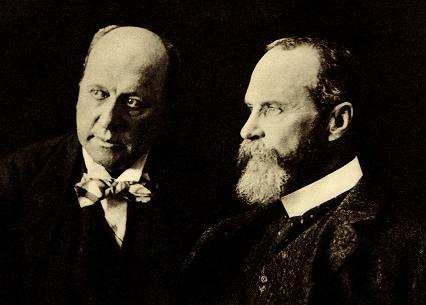"Can you stop banks acting like lemmings?
The great Larry Lessig emails me to point to a Newsweek article he wrote back in October, which I missed at the time. It’s entitled “Why The Banks All Fell Down”, and Lessig asks whether there’s a connection between his theory there, on the one hand (properly Lessig ascribes it to Avinash Persaud), and my story about the Gaussian copula function, on the other.
Here’s Lessig:
The models governing our financial system were developed in the 1950s. They were built, as Persaud explains, upon the assumption that “each user is the only person using them.” That assumption may have made sense when only the Rand Corporation (which developed the models) had the data to act upon them. But as Persaud wrote in the Financial Times in March, in “today’s flat world, [where] market participants from Argentina to New Zealand have the same data,” the assumption is nothing short of nuts. As the market shifts, the models used by all the major investment banks “throw up the same portfolios to be favored and those not to be.” This is the Heisenberg uncertainty principle for financial markets: by being observed, the observed gets changed. The global, simultaneous and practically instantaneous “adjustments” lead “the herd” (a.k.a. our financial system) right off the cliff.
The financial system is indeed full of models which make sense if only one person uses them, but which become extremely dangerous if everybody starts to use them. Here’s the relevant bit of my Wired story:
The real danger was created not because any given trader adopted it but because every trader did. In financial markets, everybody doing the same thing is the classic recipe for a bubble and inevitable bust.
The financial markets were reminded of this in the summer of 2007, when simultaneously all the formerly-very-successful quant and stat-arb hedge funds all blew up at the same time. Bryant Urstadt wrote the definitive article on the blow-up for the MIT Technology Review, which is hidden behind a registration firewall here; the gist is that all the funds were following much the same strategy (something called “pairs trading” is mentioned), and that as a result asset classes become highly correlated which were never correlated in the past.
In 2007, the damage was limited: there was a lot of fallout in the world of hedge funds, but the stock market continued to rise, and the systemic implications seemed to be contained. But the adoption of the Gaussian copula function was much more widespread than a bunch of hedge funds: it was embraced at pretty much every CDO origination and trading desk on Wall Street. And when the entire financial system starts using essentially the same model, the systemic devastation which can result is enormous.
So yes, when Persaud talks about “the market-sensitive risk models used by thousands of market participants”, he’s very much referring to things like the Gaussian copula function, which proved to be one of the best ways ever invented of shunting risk off into the tails. He’s probably also talking about the near-universal adoption of Value-at-Risk, which as Joe Nocera explains does a great job of allowing managers to ignore the tails, no matter how much risk is in them.
Persaud says that there are important implications for regulatory policy:
This brings us to the philosophical problem of the reliance of supervisors on bank risk models. The reason we regulate markets over and above normal corporate law is that from time to time markets fail and these failings have devastating consequences. If the purpose of regulation is to avoid market failures, we cannot use, as the instruments of financial regulation, risk-models that rely on market prices, or any other instrument derived from market prices such as mark-to-market accounting. Market prices cannot save us from market failures. Yet, this is the thrust of modern financial regulation, which calls for more transparency on prices, more price-sensitive risk models and more price-sensitive prudential controls. These tools are like seat belts that stop working whenever you press hard on the accelerator.
The problem is that it’s very unclear what the alternative is. The lesson of the failure of Basel II is, indeed, that you can’t trust banks to judge their own internal risks very well. But the whole reason why Basel II was created in the first place is that financial instruments are so complicated these days that it’s very easy to do an end-run around simpler regulations.
My feeling is that the best way to go is to set some very clear and simple rules, much as the Spanish central bank did, and refuse to allow banks to build enormous businesses doing things that the regulators don’t understand. And secondly to place a cap on banks’ balance sheets — I think something around $300 billion is reasonable, and that there’s no reason why any bank should be bigger than that. Alternatively, if you are bigger than that, then you have to become much more constrained in what kind of activities you’re involved in: you should basically just be doing plain-vanilla deposit-taking, borrowing, and lending.
That wouldn’t prevent future financial crises outright. But it would probably stop them from causing a major global recession."
I think that this is basically the way to go:
http://www.voxeu.org/index.php?q=node/32 32
“Regulating the new financial sector
Willem Buiter
9 March 2009″
“Narrow banking vs. investment banking
The distinction between public utility banking/narrow banking vs. investment banking; (the rest) has to be re-introduced. I advocate a form of Glass-Steagall on steroids, with a heavily regulated and closely supervised narrow banking sector, engaged in commercial banking (taking deposits and making loans) and benefiting from lender of last resort and market maker of last resort support. The investment bank sector will also be regulated and supervised, but more lightly, and according to the same principles as other systemically important highly leveraged non-narrow bank institutions.
Universal banking has few if any efficiency advantages and many disadvantages. Economies of scale and scope in banking are soon exhausted. They tend to be fat to fail, have a lack of focus, and suffer from span-of-control negative synergies etc. Universal banks or financial supermarkets use their size to exploit market power and try to shelter their risky, non-narrow banking activities under the LLR and MMLR umbrella of the narrow bank that’s hiding somewhere inside the universal bank.
Penalise bank size
Splitting banks into public utility or narrow banks does not solve the problems of banks (narrow or investment) becoming too big or too interconnected to fail. It is therefore necessary to penalise bank size per se, to stop banks from becoming too large to fail (if they are interconnected but small, they are still not systemically important). I would penalise size through capital requirements that are progressive in size (as well as leverage).”
And:
“This limited purpose banking is a modern version of narrow banking proposed by Frank Knight, Henry Simons, and Irving Fisher. Banks would hold deposits, cash checks, wire money, originate loans, and market mutual funds, including money market funds with no guarantee of par value redemption.
With limited purpose banking, financial crises would largely disappear. Banks would never fail, never stop originating loans, never expose the public to massive liabilities, and never see their stock values evaporate. Banks would be stable, boring economic cogs – like gas stations.
The Fed would also gain full control of the money supply. To expand the money supply, the Fed would continue buying Treasuries from the public and supplying cash. But banks wouldn’t be multiplying and contracting M1 (cash plus demand deposits) based on their ever changing decisions about lending deposited funds.
Milton Friedman, who also advocated narrow banking, blamed the Depression on the Fed’s failure to offset the M1 money multiplier’s collapse. In the past year the M1 multiplier has contracted by over 40 percent, forcing the Fed to double base money. If the multiplier shoots back up, we could see the money supply and prices explode.
What about investment banks, brokerage firms, hedge funds, and insurance companies? What’s their right financial order?
Again, regulate to purpose.”
- Posted by Don the libertarian Democrat Your comment is awaiting moderation. "






































No comments:
Post a Comment